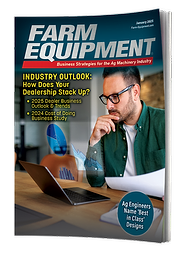Bob Clements of Bob Clements International and President of Business Development, Sara Hey, have valuable information on improving dealership performance. There are five blind spots that can often cause dealerships to unintentionally lose revenue, they say.
“Inside of dealerships right now, there are a lot of different things that are vying for your attention, and it's really easy to have blind spots in the midst of this, where we're just stepping over cash over and over again,” says Hey. “Recognizing and evaluating current practices is the initial step toward resolving these issues.”
Here are the 5 blind spots:
1. Understanding the Importance of Triaging
Triaging allows dealers to assess equipment upon arrival and prepare for repairs in advance, which can significantly reduce service times and improve customer satisfaction.
Rather than waiting until you're ready to start working on it and then looking at it and saying, oh, I got a tractor that needs a new clutch or it needs bevel gears for the transmission … why not do that sooner?” Clements says.
Hey adds another crucial dimension to managing dealerships by emphasizing the need to view time as a form of inventory. “Your inventory that you have in the service department expires at the end of every single day, and you buy it eight pieces at a time,” she says. “What is your inventory? It is time.”
Even minor inefficiencies can lead to substantial financial losses over time. Losing one hour a day in the service department costs $66,000 annually at ‘Sara’s Magical Dealership,’ according to Hey.
2. Pricing & Managing Parts Strategically
Making sure that you are listing your parts at a profitable price is something that should be strongly considered when running a dealership.
Clements recommends dealers move beyond relying solely on Manufacturer’s Suggested Retail Price (MSRP). “MSRP is based upon that part being sold a minimum of four times a year,” he says. “If you only sell that part three times a year, MSRP doesn’t work anymore.”
Some people treat MSRP as a rule instead of a suggestion, so Clements says pricing strategies should be more flexible, using different tools or ways to analyze potential profitability. There are multiple ways to do this, such as pricing matrix and velocity pricing to adjust prices based on parts turnover and market competition.
Managing your parts inventory effectively is very important as well, says Hey. Inefficient parts management, particularly if technicians pull their own parts, can result in lost revenue and inaccurate inventory tracking.
“Having technicians look and pull their own parts is the most expensive thing that you can have those technicians do inside of the parts department,” she says.
3. Selling in Bundles
Hey says offering bundles and having everything in one place that the customer may need takes tension out of their buying experience and keeps them away from shopping with your competitors. She uses the fast food industry to explain the benefits of bundling:
“You can buy a cheeseburger and if you wanted to go to McDonald's to get a Diet Coke because it's superior than all other Diet Cokes, that's fine,” says Hey. “Then, you go over to Freddy's to get the fries because you want to make a good choice, you could do that, but it brings friction into the experience. It's much easier if you say that you’re just going to get a meal.”
4. Sales & Marketing Alignment
Clements stressed the importance of high sales activity, likening it to baseball: “Selling is about activity. It's like baseball, the more times you get up to bat, the higher probability you're going to get on base.”
He also advises sales teams to track their performance metrics. If one sale equals $10,000, it took me five walk-arounds or five quotes to get one sale," Clements says. Now I know that each walk-around or each quote is worth $2,000.”
Just because a few sales fall through shouldn’t mean you stop trying to sell a certain product or service. Continue to pursue customers to purchase the product and maybe even increase your efforts, he says.
Hey complements Clements' statements with a critique of reactionary marketing practices. She argues that effective marketing requires a strategic approach.
“Marketing is effective if we are not just reacting to the marketing, but that we have a plan in place to attack the marketing,” she says.
It is important to plan marketing strategies in advance to avoid ineffective, last-minute campaigns.
There needs to be clear metrics for evaluating marketing effectiveness. “The only thing that matters in marketing is lead generation,” Clements says. “If they're not doing things that generate leads, your marketing is not working.”
5. Hiring the Right People
Hiring the right personnel is something that applies to every business. “The hardest thing to get rid of is a body, so don't bring them on if you don't have to,” Clements says. He also stresses that hiring decisions should be based on qualifications and potential fit rather than merely filling positions. Additionally, salaries should align with departmental gross profits rather than overall revenue to maintain financial health.
Clements says job descriptions should include performance requirements linked to compensation. “Every job description should have a performance requirement to it,” he says. This ensures that salaries reflect performance, enhancing overall dealership efficiency.
Addressing these five blind spots can significantly impact a dealership's profitability. As Clements puts it, “The easiest place to start on getting things right is always in the service department.” By focusing on these areas, dealerships can better manage resources, improve service quality and enhance overall financial performance.
For more details, including access to additional resources, the webinar is available on the Rural Lifestyle Dealer website.





